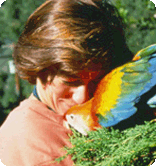Avoiding behavioral problems in Cockatoos

Dear Phoebe, When raising young cockatoos, what are the best ways to avoid behavioral problems when cockatoos become adults? Thanks,
Nic Miller

Hello Nic, and thanks for writing World Parrot Trust. By becoming a supporter of World Parrot Trust, you’ve already made a good decision that can have far-reaching positive ramifications for your captive cockatoo companion, so kudos! Stay interested. Keep questioning.
Here are some recommendations to help you and your captive cockatoo live together in companionship and understanding.
1) Learn everything you can about parrots -- become a well-versed generalist. Read extensively, especially everything on the WPT site which is like being in Parrot University, plus watch videos of parrots in the wild, and then become active in an issue surrounding captive parrots which is meaningful to you.
2) Along the way, develop a keen specialized knowledge of the species of cockatoo you intend to keep captive and know their wild habitats, habits, flock sizes, seasons, indigenous food preferences (if known) and so on.
3) Participate in conservation efforts that enhance the lives of your captive’s wild cousins. This will help deepen your compassion for the type of parrot you keep.
4) Establish a friendly and supportive relationship with an avian veterinarian and her/his staff and discuss specific medical, social, nutritional concerns with her/him. Follow her/his advice but don't be shy about getting a second opinion, especially if the advice you first receive is contrary to what's documented on this site.
5) Take the on-line class Living and Learning with Parrots, no matter who teaches it. Participate in on-line discussions (even if you just lurk at first), attend seminars, go to conferences, think deeply well into the night on issues.
6) Before you buy the cage, stick your head and shoulders in it and look around. If it's not big enough for you to do that, the cage is too small.
7) Once you've got a big enough cage, stick your head and shoulders inside it, or sit on the stoop and check out the interior: notice where the bowls, perches and enrichment items are and envision how a smallish body, with two zygodactyl feet (two toes pointing forward, two pointing backwards) would make her/his way through this space. This might take practice, but keep trying. You’ll adapt. You're sure to get the point well before 8 consecutive hours of this exercise.
8) Speaking of exercise, when you're in the cage, how do you stretch? Flap? Where are the foraging areas and how do you get to them? Where do you sleep? How about privacy and shade? If you were the size and temperament of your parrot, how would you rate the interior of the cage? Make it fabulous. Make the primary cage a place where, if other cockatoos came to visit, they'd be like, whoa man, this is cooooool.
9) Still inside the cage, check it out: How's the view? If you live with other parrots, chances are from the inside of your cage, you mainly see other cages. If you were the size of your parrot, how would you rate the interior of the cage?
10) As the human who is 100% responsible, make every single environmental adjustment you can to enhance the cockatoo's well-being. Create spaces, scenarios and enticements specifically designed from her/his point of view and commensurate with her/his physicality and abilities. Continue this without flagging.
11) Realistically assess your physical surroundings and make interior and exterior spaces commensurate with your captive cockatoo's capabilities, innate propensities and your ideals of multi-species companionship. Keep in mind, always, the fact that your captive has, without their permission, given up the notions and the realities of like-species companionship and all that entails. Denied the knowledge of other cockatoos' voice and touch, your captive needs you to assess her/his needs, respect them, and fulfill them. Absent from flock life and its myriad lessons, apart from wisdom of grandparents, parents, siblings and native communities, your captive depends on you to supplement their captive-life curriculum with On-Going Benevolent Lessons in Captivity. Also, add more cockatoo-friendly hang-out areas than you think you need.
12) Consider cockatoo noise-making a legitimate form of communication, a way of life, an expression of emotional complexity, a necessary physical release, and a symphony in praise of bio-diversity. Get used to it.
In conclusion, the best advice I can give is to keep learning. Contribute as much as you can. Consider the cockatoo individual who inhabits your space as your personal representative of the huge wild imperiled earth and act, always, accordingly.
All best,
Phoebe Greene Linden
Santa Barbara Bird Farm

































